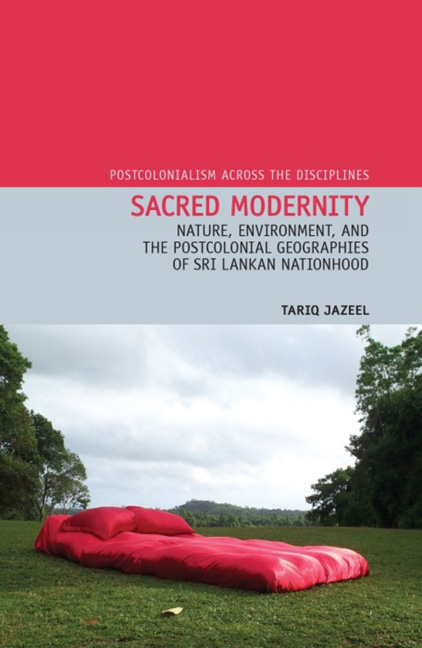Book contents
- Frontmatter
- Dedication
- Contents
- List of Map and Figures
- Acknowledgements
- Introduction
- 1 Sacred Modernity: Nature, Religion, and the Politics of Aesthetics
- Part I Ruhuna (Yala) National Park
- Part II Tropical Modern Architecture
- 5 Built Space, Environment, Modernism: (Re)reading ‘Tropical Modern’ Architecture
- 6 Architecting One-ness: Fluid Spaces/Sacred Modernity
- 7 Over-determinations: Architecture, Text, Politics
- Conclusion: Sri Lankan Nature as Problem Space
- Bibliography
- Index
5 - Built Space, Environment, Modernism: (Re)reading ‘Tropical Modern’ Architecture
from Part II - Tropical Modern Architecture
- Frontmatter
- Dedication
- Contents
- List of Map and Figures
- Acknowledgements
- Introduction
- 1 Sacred Modernity: Nature, Religion, and the Politics of Aesthetics
- Part I Ruhuna (Yala) National Park
- Part II Tropical Modern Architecture
- 5 Built Space, Environment, Modernism: (Re)reading ‘Tropical Modern’ Architecture
- 6 Architecting One-ness: Fluid Spaces/Sacred Modernity
- 7 Over-determinations: Architecture, Text, Politics
- Conclusion: Sri Lankan Nature as Problem Space
- Bibliography
- Index
Summary
In a quiet spot on the banks of Lake Deduwa on Sri Lanka's southwest coast, lies the sprawling estate of Lunuganga, the home and garden of the late Geoffrey Bawa, perhaps the best-known of Sri Lanka's ‘tropical modern’ architects. Now owned and run as a boutique hotel by the Lunuganga Trust, this twenty-fiveacre assortment of stunning landscapes and eclectic architectural experiments (Figures 5.1, 5.2, and 5.3) was Bawa's country retreat from 1948 until his death in 2003. Set amidst a backdrop of unceasing tropical growth in this wettest and most fertile region of Sri Lanka, the estate straddles two hills and juts into the lake. Originally jungle, the land was planted with cinnamon, then rubber and hardwoods up to the early twentieth century. When Bawa bought the estate in 1948, he chose to keep the main house on the northern hill, opening up the landscapes and vistas around it with slow but steady precision, imagination, and purpose. Over the next half-century, the garden and estate evolved in dimension and texture. Today, its open spaces, terraces, and ornamental paddy fields are liberally sprinkled with statues, pavilions, and walls, all of which form part of the estate's careful choreography. Though not always paralleling one another stylistically, the evolution of the estate and the development of the architect's career as perhaps the most well- known proponent of Sri Lanka's emergent tropical modern architectural style are entwined with one another. As one of Bawa's chief commentators, David Robson, has written:
Here he held court, drawing together a circle of painters, designers and architects and plotting with them to write a new chapter in the history of Sri Lankan art and architecture. Here he also developed and honed new ways to set buildings into their site, to create enclosed and semi-enclosed outdoor spaces, to link interior with exterior. (Robson 2002: 238)
If Lunuganga was the private estate and plaything of Sri Lanka's most famous, and arguably influential, modernist architect, stylistically it is perhaps not the best example of Geoffrey Bawa's proximity to the international modernism for which he is famous.
- Type
- Chapter
- Information
- Sacred ModernityNature, Environment and the Postcolonial Geographies of Sri Lankan Nationhood, pp. 95 - 120Publisher: Liverpool University PressPrint publication year: 2013



